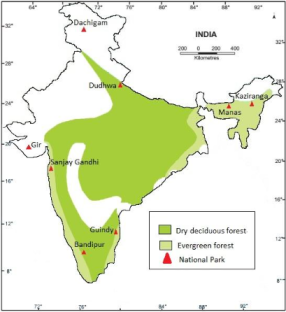Find SST Complete Natural Vegetation And Wildlife Class 9 Questions And Answers With Detailed Explanations
FAQs on NCERT Solutions For Class 9 Social Science Chapter 5 Natural Vegetation And Wildlife - Contemporary India
1. What are the step-by-step solutions for Class 9 Social Science Geography Chapter 5 as per NCERT guidelines?
The NCERT Solutions for Class 9 Social Science Chapter 5 provide a detailed, stepwise approach to answering each exercise question from ‘Natural Vegetation and Wildlife.’ Each solution follows the CBSE pattern, ensures conceptual clarity, and presents answers in precise, exam-appropriate language. Key steps include:
- Understanding the question's demand
- Identifying the relevant concept from the chapter
- Structuring the answer in clear points or short paragraphs
- Including supporting reasons, examples, or diagrams where applicable
2. How do the NCERT Solutions help in preparing for CBSE 2025–26 Class 9 exams in Geography Chapter 5?
NCERT Solutions for Class 9 Social Science Geography Chapter 5 are aligned to the latest CBSE 2025–26 syllabus. They simplify complex concepts, provide pointwise explanations, and enable students to practice CBSE-style answers, enhancing preparation, conceptual understanding, and exam confidence.
3. What factors affect the distribution of natural vegetation and wildlife in India, as explained in Class 9 Geography NCERT Solutions?
The NCERT Solutions explain that the distribution of natural vegetation and wildlife in India depends on:
- Climatic factors (temperature, rainfall, photoperiod)
- Relief features (altitude, landforms)
- Soil types and fertility
- Human intervention and conservation measures
4. Compare tropical evergreen and deciduous forests as per NCERT Solutions for Class 9 Social Science Chapter 5.
The key differences outlined are:
- Tropical evergreen forests: Dense, remain green year-round, found in areas with rainfall over 200 cm; common species include rubber, ebony, mahogany.
- Deciduous forests: Shed leaves in a specific season, occur where rainfall is 70–200 cm; species include teak, sal, and bamboo.
5. Why are some plant and animal species endangered in India, according to Class 9 NCERT Solutions?
As covered in NCERT Solutions for Chapter 5, reasons for endangerment include:
- Loss of habitat due to deforestation and urbanization
- Illegal hunting and poaching
- Pollution of soil, water, and air
- Climate change affecting habitats
6. Explain the concept of a bio-reserve with two examples from the NCERT Class 9 Social Science Chapter 5.
A bio-reserve is a protected area dedicated to conserving biodiversity, including unique flora and fauna. Examples provided in the solutions include Sundarbans Biosphere Reserve and Nilgiri Biosphere Reserve.
7. What are the major types of natural vegetation described in Chapter 5 NCERT Solutions for Class 9 Geography?
Chapter 5 identifies the following types:
- Tropical evergreen forests
- Tropical deciduous forests
- Tropical thorn forests and scrubs
- Montane forests
- Mangrove (tidal) forests
8. How does the NCERT solution approach diagram-based questions, for example, labelling forest areas on a map?
The NCERT Solutions recommend:
- Studying the map provided in the textbook
- Carefully labelling the specified forest regions and national parks
- Following CBSE exam guidelines for neatness and accuracy
9. How do the answers in NCERT Solutions for Class 9 Social Science Chapter 5 follow CBSE marking schemes?
The solutions are structured to match CBSE's expected answer format, using bullet points or concise paragraphs, presenting facts and explanations according to marks distribution (1/2/3/5 marks), and directly addressing all parts of each question.
10. What is an ecosystem as defined in NCERT Solutions for Class 9 Geography Chapter 5?
An ecosystem is defined as a system formed by the interaction between living (biotic) and non-living (abiotic) components in a specific environment at a given time. Examples include forests, ponds, and grasslands.
11. FUQ: How does changing vegetation affect animal life, according to the NCERT Solutions for Chapter 5?
The solutions explain that animals depend on local vegetation for food and habitat. Thus, when vegetation changes (due to climate, altitude, or human activities), animal populations and diversity also change, demonstrating the interdependence within ecosystems.
12. FUQ: What misconceptions do students often have regarding virgin vegetation and how does the NCERT Solution clarify this?
Many students believe all uncultivated plants are virgin vegetation. However, NCERT Solutions clarify that virgin vegetation refers only to natural plants grown without direct human influence, excluding agricultural or introduced species.
13. FUQ: Why is India considered to have a rich heritage of flora and fauna, as detailed in NCERT Solutions for this chapter?
India's rich biodiversity is attributed to its varied geography (mountains, plains, coasts), diverse soils, variable climate, and long evolutionary history. The NCERT Solutions highlight how this combination results in different natural habitats supporting wide species diversity.
14. FUQ: How should students approach answering value-based or application questions in NCERT Solutions for Natural Vegetation and Wildlife?
Students should:
- Relate their answers to real-life situations or contemporary environmental issues
- Apply concepts like conservation, climate impact, or sustainable development
- Justify their viewpoints with facts and textbook references
15. FUQ: How can studying NCERT Solutions for Class 9 Social Science Chapter 5 help build skills for higher classes and competitive exams?
Practicing with NCERT Solutions fosters better analytical thinking, concept application, and structured answer writing—core skills required for higher-level Geography questions and competitive exams like NTSE, Olympiads, and CBSE board exams.
































